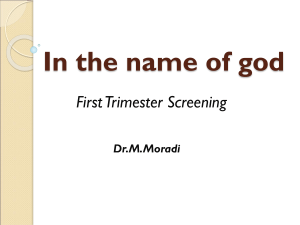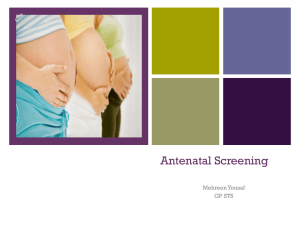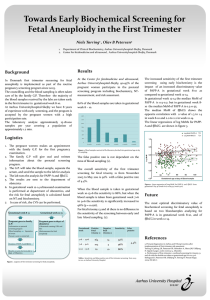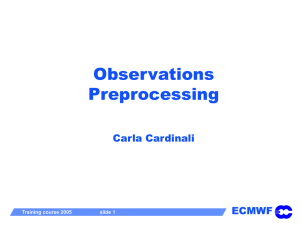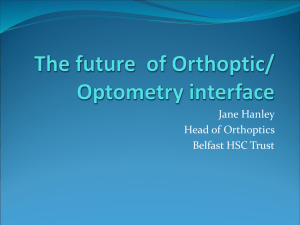Fetal Anomaly - JANUARY 2010
advertisement
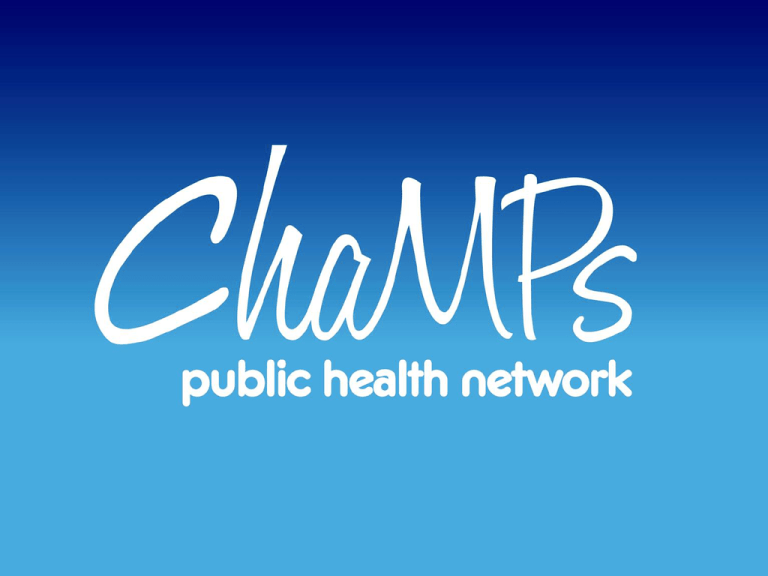
NHS Fetal Anomaly Screening Programme Marie Coughlin Screening Lead January 25th 2010 Today’s Session First of 6 Antenatal & Newborn sessions throughout 2010 Same format will be used – feedback on this would be useful Reasons for Today’s Session As a result of ChaMPs commissioned review of screening A need to further engage public health in Antenatal & Newborn Screening Programmes At the request of public health screening leads Part of C&M Screening Action Plan Thought it useful to invite commissioners also Aim of the Session To increase knowledge base within public health Session Format Overview of UK NSC/NWSHA structure Overview of Fetal Anomaly Screening Review of patient pathway Data and QA Future developments Questions/comments Overarching Structure UK NSC oversees 6 Antenatal & Newborn Screening Programmes SHA coordinators with regional and national role NWSHA coordinator jobs out to advert UK NSC has defined accountability & governance structure for SHA, PCT and provider Purpose of Fetal Anomaly Screening Aim to offer women 2 ultrasound tests at 10-12 weeks and 18-20 weeks of pregnancy First scan for dating and pregnancy viability Second scan screens for major structural anomalies Down’s Syndrome Screening Programme now part of Fetal Anomaly Screening Programme Screens for down’s syndrome between 10-18 weeks depending on local screening strategies Cont… Aspires to give women an informed choice Does not screen for all conditions For down’s syndrome only gives an indication of risk, does not confirm Unlike other screening programmes, emphasis not on high uptake rates Cont... Conditions screened for: — Alobar Holoprosencepathy (HPE) — Anencephaly — Bilateral Renal Agenesis — Cleft Lip/Palate — Congenital Diaphragmatic Hernia (CDH) — Congenital Heart Disease — Down’s Syndrome Cont… Conditions screened for: — Edward’s Syndrome (Trisomy 18) — Exomphalos (Omphalocele) — Gastroschisis — Lethal Skeletal Dysplasia — Spina Bifida — Trisomy 13 (Patau’s Syndrome) Patient Pathway… NHS Fetal Anomaly Screening Programme (FASP) Rebecca Till Screening Midwife Macclesfield District General Hospital 26th January 2010 Aim Programme breakdown Strategies & Tests Pathways Fetal Anomaly Screening Programme UK National Screening Programme Chromosomal (Down’s Syndrome Screening) Equality of access Structural (18-20+6 Week anomaly scan) Equitable Service Down’s Syndrome Screening Recommendations 75% detection rate (DR) for 3% false positive (FP) 90% detection rate (DR) for 3% false positive Benchmark timeframe - April 2010 QuickTime™ and a None decompressor are needed to see this picture. Screening Strategies 1st Trimester Combined Quadruple Test QuickTime™ and a None decompressor are needed to see this picture. 1st Trimester Combined Biochemical markers in maternal serum (10-14 weeks) BhCG PAPPA-A 87%DR - 3%FPR (1:150) Nuchal Translucency Scan (11-13+6 weeks) QuickTime™ and a None decompressor are needed to see this picture. The Quadruple Test (2nd Trimester) 15-21+6 weeks Gestation Maternal Age Ethnicity Smoking Weight 84% DR - 5% FPR PAPP-A PAPP-A Alphafeta Alpha-feta Protein Protein BhCG BhCG Unconjugated Unconjugated Oestriol Oestriol QuickTime™ and a None decompressor are needed to see this picture. Fetal Anomaly Ultrasound Aims & Objectives Two Ultrasound Scans PAPP-A Structural Dating & Anomalies Viability (8+ (18-20+6 weeks) weeks) Screening Choices Management and Termination Options QuickTime™ and a None decompressor are needed to see this picture. Verbal Consent Fetal Anomaly Ultrasound Abnormalities Development Show fetus/heartbeat Listed anatomy Measurements Discuss results Printed handout QuickTime™ and a None decompressor are needed to see this picture. Patient Pathway and Timelines Screening Timeline Pathway for Trisomy 21 Screening Pathway for raised NT > 3.5mm Pathway for Fetal Anomaly Screening QuickTime™ and a None decompressor are needed to see this picture. Conclusions Robust Implications on Implementation Resources QuickTime™ and a None decompressor are needed to see this picture. Data, Performance & QA Very difficult to obtain data – not held centrally Trusts required to produce annual report QA for laboratories Developing QA for the rest of the service – NW coordinator roles will aid this Future Developments 1st trimester screening for Down’s Syndrome to be implemented by April 2010 — C&M PCTs not on target for this QA function to be developed further I.T. system to improve data collection to be developed Questions/Comments How/who monitors annual reports within PCT organisations? How can we achieve 1st trimester screening by April 2010? With regard to QA, how do we assure our Boards that local programmes run satisfactorily? My Questions Did you find this session useful? What will you do differently as a result of this session? Thank You
